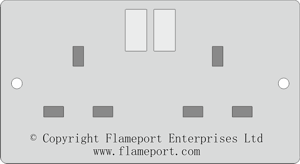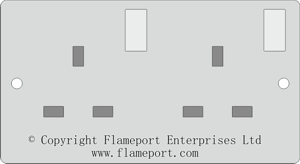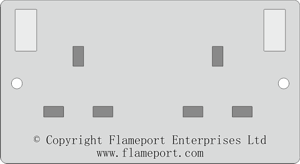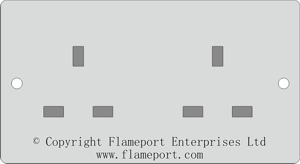Socket Outlet Circuits
There are two basic forms of circuit used for socket outlets. Radial and Ring.
In this section
Socket Outlets
Plug Socket
Double pole, single pole or neither?
Simple radial circuit
Ring final circuits
Radial circuit with branches
Adding a spur to a ring final circuit
Extending a ring circuit using a junction box
Extending an existing ring final circuit
Socket Outlets
 A socket outlet is the familiar item mounted on the wall into which a plug can be inserted. It is available in single and double types.
A few manufacturers also make triple and quad versions.
A socket outlet is the familiar item mounted on the wall into which a plug can be inserted. It is available in single and double types.
A few manufacturers also make triple and quad versions.
A single socket outlet is rated at 13 amps. A double socket outlet is NOT rated at 26A - it 13A shared between the two outlets. Therefore if you intend to have two high power appliances in the same place, two single sockets are better than one double. The most common situation where this arises is for a washing machine and tumble drier.
Triple and quad versions are also 13A shared between the outlets, and these will have a 13A fuse fitted into the front of the socket. These types usually fit onto a standard single or double backbox, proving a quick way to install further outlets.
Other switch variations
Plug Socket
A ghastly and annoying term used by many people. No such thing (any more). There are sockets, and there are plugs. Not both at the same time. While in rant mode, also note that light switches are not sockets, and the place where your 'lightbulb' fits is a lampholder, not a light socket. If it was a light socket, then presumably there would also be a heavy socket somewhere?
Double pole, single pole or neither?
Rather obviously, switched socket outlets are those with switches on them. Not so obvious is that some are single pole (where only the live is switched) and others are double pole (both live and neutral are switched). Double pole switching might seem safer, but the circuit breakers or fuses in your consumer unit only switch the live, the neutral is permanently connected.
Double pole switched sockets cost slightly more than the single pole versions.
Unswitched sockets have no switch at all. Switching is done by unplugging the appliance. Useful to avoid someone accidentally switching them off, or where a switch is provided elsewhere. One example is a socket under a worktop for a washing machine, which is connected via a switch mounted above the worktop.





